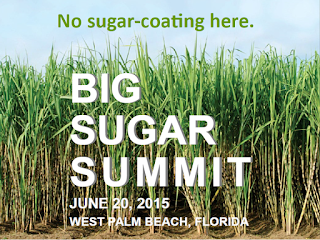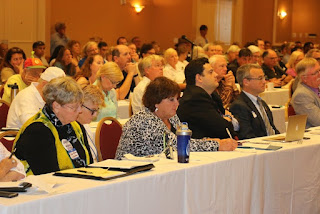June 30, 2015
How Do We Cut Big Sugar Down to Size?
Big Sugar Summit Held June 20 in West Palm Beach

The intention was to pull the curtain back on the sugar industry. We wanted to dig as deep into the muck as we could, in one day, to uncover just how profoundly Big Sugar affects us all.
Why? Because after the November 2014 elections, the South Florida Water Management District Governing Board’s refusal to buck Big Sugar, and the 2015 Florida Legislative sessions, it became crystal clear that Big Sugar rules Florida (for now). We need to take a different approach to tackling the stranglehold Big Sugar has on all of us, and the way to begin is to learn as much as possible about the industry's impact on Florida and its citizens.
Two hundred and fifty seven citizens packed the West Palm Beach Embassy Suites ballroom for over eight hours on June 20. They not only heard 14 speakers from a wide variety of disciplines and from each end of the political spectrum, but they also joined the conversation.
The dialogue started with the founder of The Everglades Trust, Mary Barley's opening remarks recounting her personal, decades-long battle to rein in Big Sugar for the sake of Everglades restoration.
Dr. Gail Hollander, associate professor of geography, Department of Global & Sociocultural Studies, Florida International University, author of Raising Cane in the ‘Glades: The Global Sugar Trade and the Transformation of Florida, took attendees on a ride back through history to discover how and why Big Sugar landed in South Florida and more specifically in the Everglades Agricultural Area.

Richard Grosso, Director, Environmental and Land Use Law Clinic, Broad Law Center, Nova Southeastern University, gave the crowd a lesson in how Sugar Hill City, a development proposal pursued by U.S. Sugar Corp. and the Hilliard Brothers, is not only a real threat to public safety and the progress of Everglades restoration but also a supreme example of just how powerful Big Sugar is.
The keynote address by Chairman Colley Billie of the Miccosukee Tribe of Indians was the highlight of the day. Chairman Billie's deep conviction that water quality in the Everglades must be the top priority, and that we must work together to achieve a high standard of water quality, was impressed upon everyone in the room.
The subsequent panel, titled "Is Big Sugar Burning Your Lungs," included Julia Hathaway, Organizing Representative, Sierra Club; Dr. Henrique César Santejo Silveira, Molecular Oncology Research Center, Barretos Cancer Hospital, Barretos, SP, Brazil; Jim Stormer, Retired Environmental Administrator, Palm Beach County Health Department; and David Guest, Managing Attorney, Earthjustice, Florida Office.
All spoke on the subject of the damaging, outdated practice of pre-harvest burning of sugarcane fields in South Florida. How sugar growers profit at the expense of public health in the EAA was a special point of interest for many attendees. See here for a more expansive description of the panel's offerings.
Next on the agenda was Wolfram Alderson, Founding Executive Director, Institute for Responsible Nutrition, who had the most "digestible" of all the presentations. Alderson offered the facts on sugar consumption, its role in human health (or lack thereof), its global impact, and the ubiquitous presence of added sugar in the U.S diet.
The final panel covered Big Sugar's political influence and featured our most diverse set of speakers. Daren Bakst, Research Fellow in Agricultural Policy, Institute for Economic Freedom and Opportunity of The Heritage Foundation, proved to everyone in the room that uncommon partnerships may be the answer; the federal sugar program, anathema to just trade policy and consumer protection policy, is a target of both the left and right ends of the political spectrum.
Sheila Krumholz, executive director of the Center for Responsive Politics, brought all the truly disturbing news of just how many Big Sugar dollars make their way into political decisions and election results at the federal level. After all that, she inspired the crowd with her optimism that voters and well-informed citizens can still and must fight back.
Manley Fuller, president of Florida Wildlife Federation, who has seen it all at the state level for decades of the Everglades restoration struggle, brought the formal program to a close.
Last, but certainly not least, was the open microphone at the end of the program where attendees had the opportunity to share ideas, pose questions, and propose next steps.
Frank Jackalone, Florida staff director of the Sierra Club, summed up by noting that the future of our entire state, and not just South Florida, depends on our winning this fight to cut Big Sugar down to size.
For more Big Sugar Summit follow-up, visit and re-visit to this link where photos, presentations, videos and opportunities for further discussion will be posted as they become available.